Don't wanna be here? Send us removal request.
Text
That’s a wrap
That’s it for now, I’m officially closing this blog until our borders open again and I can go back to this wonderful continent and explore more of its spectacular landscape, great culture and fingerlickin’ good food.
Here is a bit of a map with all the locations I’ve been to and a link back to the corresponding blog entry. As you can see I didn’t make it very far and there is still a lot to see.

0 notes
Text
Why Canada was a fail for me
This doesn't have much to do with my trip through South America but I needed a place where I can put it and it is at least a little bit related. One thing people asked me a lot is why I didn't want to stay in Canada and decided to go back to Australia. As always there isn't one specific reason I could pinpoint it to, it rather is a combination of things.
Generally speaking, pretty much everything felt like a step back and not many things felt like an improvement. And don't get me wrong, Canada is a beautiful place and nothing was terrible. But to me Australia is simply that little bit ahead.
I should also mention that my experiences are heavily skewed by how life is in British Columbia and specifically in Vancouver. Similar to Australia you have huge differences between states and cities. Laws, regulations and even culture between them vary a fair bit. And whilst some things might potentially be better in other regions, they are not an option for me simply due to the climate. Vancouver is the only place in Canada with mild winters which is one of my most important criteria when it comes to choosing where I want to live.
So here are all these little reasons why I didn't like Canada, roughly ordered by priority. And the first one is actually related to climate.
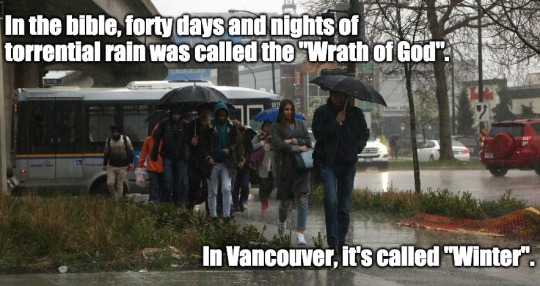
1) Summers are too short and winters are too wet I'm a summer person and if I could choose, I would be happy to live in a place where it's 30 degrees and sunny all year around. The variety of seasons is something I don’t need and I definitely also don't need rain. In Vancouver you have between 4 or 5 months a year with beautiful sunny days and 7 or 8 months with absolutely miserable shit weather. The summer bit is great, in fact it hardly rains during that time at all. But the winter - oh my god. I expected that it would rain a lot but there is still a huge difference between reading that stuff from a climate chart and actually experiencing it. There were weeks when it just wouldn't stop raining. During my last days in Vancouver I definitely felt getting depressed from the constant grey skies. And whilst winters in Melbourne can also be rainy and cold, it's at least easy to escape from it by travelling just a little bit up North (which I usually try to do). But in Canada there is just no escape. It would just get worse.
2) Not enough time to play Due to the summer/winter ratio described above, there is actually just a very small window that can be used to enjoy the magnificent outdoors surrounding Vancouver. There are heaps of great hiking trails, lots of beautiful lakes and hundreds of mountain peaks to climb - but it always takes a while for all the snow to melt and then you have only about three months to explore. And obviously you are not the only one who wants to do that. In Australia however, you practically have the whole year to explore something if you just time it right (and if there is no pandemic disrupting everything). But even in Melbourne you can usually still do lots of hikes close to the city in the colder months because a sunny winter day there feels like a normal spring day in Germany or Canada.
3) The ocean sucks I was hoping that Vancouver would be a good compromise where you can have wonderful mountains and the beautiful ocean right at your doorstep. And whilst you technically have both, the ocean unfortunately just sucks. It sucks so much, the mountains can't make up for it. The water temperature doesn't get any higher than 20 degrees in summer and as low as 5 degrees in winter. And for the vast majority of time it's in the colder range. But it doesn't stop there: Water visibility is super low all year around which means that you don't see any wildlife when you go for a swim. Also you have plenty of logs floating in the water which you often only notice seconds before colliding with it. To top it all off the beaches leave a lot to be desired. The sand feels more like dirt, it's very brownish in colour and gets extremely crowded in summer. Melbourne surely doesn't have the most beautiful beaches in Australia but they are at least a million times better than what I've found in Vancouver.
4) Design as a job discipline is 10 years behind For people who don't work in tech, it's probably sufficient to know that I felt like I was back in 2010 (or back in Germany) when I started looking for a job. In the vast majority of design roles, organisations were looking for the infamous UI/UX designer. And those jobs were usually very UI heavy. It was an exception to find pure UX roles and specialised roles like UX researchers were nowhere to be found. Design as a discipline was generally years behind and didn't play an important role in product strategy. At work I had to fight battles that I thought I'd never have to fight again and was able to impress people with things that are just standard in Australia by now. I learned a lot of other job related things during my time in Canada, but I definitely didn't learn a single new thing about design.
5) The people Disclaimer: You find all sorts of people everywhere. Nice people. Stupid people. Assholes. But there are still trends and behavioural tendencies. The people in Canada were broadly speaking not as friendly, not as relaxed, not as open and definitely not as quirky as people in Australia. They were actually very... German! No Hello, how are you in the elevator, no smile when you approached a stranger to ask for something, not even a Have a nice day when you paid at the supermarket. It's a bit hard to explain, but I missed the warmth and openness of the Australian people.
6) Digitisation my ass Closely related to the point about design, digitisation in Canada is simply not as advanced as in Australia. Most apps were cumbersome to use, booking tickets for the movies required a ridiculous amount of effort and forget about quickly doing your tax return online. It actually felt like in Germany which is also years behind when it comes to being smart with digital technology to make our lives easier.
7) It's expensive Melbourne and Vancouver are probably on the same level when it comes to cost of living. Rents are similar, cost of grocery is similar, movie tickets are similar, everything is very similar. But there was this little 30% wage cut I had to take when I started looking for jobs in Vancouver. How exactly do people save money in this city?
8) Bureaucracy A lot of times it felt like I was back in Germany when I tried to do things in Canada. They had a little form for everything. I lost track how many forms I had to fill in when I moved into our apartment and how many more when I left. And don't get me started about opening a bank account (see point 9). Of course all of that stuff also had to be signed and then sent back via post (see point 6).
9) Banking is a joke - and not a good one One thing I only started noticing during my first few months in Canada is how advanced the whole financial services system in Australia is. Cards that can be used for debit and credit purchases have been the norm for years, bank transfers are processed in seconds, the ability to do these transfers with just a phone number or an email address is baked into the system and the apps - how useful and convenient are the banking apps! I noticed this stuff because in Canada they try to make each of your experience that is related to money as awful as possible. I had to juggle with multiple cards, for each direct debit instruction I had to walk into a branch, my credit card was limited to a ridiculous small amount, I had to deal with fucking cheques for the first time in my life (multiple times!) and believe it or not: A simple bank transfer is actually not possible! You can't just log in to your online banking and instruct your bank to transfer money to another account from another bank. I think there were at least a million moments when I just couldn't believe how hard it was to deal with money in Canada. I could go on about this point for much longer but I guess everybody is getting the point. Hell, even the banking system in Germany is actually advanced compared to that shit in Canada.
10) The health system is weird As a diabetic it is quite important for me to make sure I get the care I need. And fortunately I ended up getting it, but the system is a bit... strange. The best healthcare system can probably be found in Germany. As far as I know, everybody has insurance, everybody gets a card from their insurer and when they get sick they go to a doctor, show their card and everything is being sorted and paid for in the background. Same is true for your medication. Reality can be a bit more complicated than this, but in its core this is how it works. Things are a little different in Australia but the main difference is that you can't just go everywhere with your Medicare card. You need to look for specific doctors and also when you need medication you might have to pay for some of it out of your own pocket - but it's usually only a small amount. Canada is just plain weird though: Whilst most of your doctor visits are paid for when you are enrolled in public healthcare, your medication isn't. 0%. You need to get private insurance for that. But very often your employer gives you some sort of insurance that covers it. Generally speaking it was just weird and the complicated way it was set up didn't really make much sense to me.
11) Sick leave and personal leave I'll just leave these (simplified) numbers here:
Personal leave in Canada: 10 days Sick leave in Canada: 5 days
Personal leave in Australia: 20 days Sick leave in Australia: 10 days
Personal leave in Germany: 28 days Sick leave in Germany: Unlimited
In my first job interview, they were actually bragging about the high number of leave days they have in Canada. I guess they made the mistake of comparing themselves to the US and A.
12) The number of druggies was insane I used to live close to the main station in Düsseldorf and I used to live in St Kilda. They’re probably not the big drug hubs of the world but surely have a fair amount of dubious characters wandering around. And it was nothing compared to what I saw every day in Vancouver. The first day I left my job through the side entrance, I was welcomed by a couple of used needles on the ground. It happened numerous times that I cycled to the parking lot of my apartment and saw people injecting drugs publicly without a care in the world. People who were clearly high on drugs yelled at other people in the streets and it seemed to be just normal to live with it and ignore them. You also had a high amount of homeless people in the streets and it was just heartbreaking to see these severe social problems and that the government clearly seems to be overwhelmed dealing with the situation and finding a good way to solve it.
13) Little, little things This is just a random list of other little inconveniences I encountered in the land of maple syrup:
You have to hand in all your physical driver licenses to get a Canadian one... and the one I got was only temporarily and had to be renewed every 3 months... by walking into a fucking branch every time (see point 6)
Mobile plans in Canada are ridiculously expensive and don't include much data
The bacon in Canada is super greasy and thin and has a weird consistency
The coffee is bad
The iced coffee is even worse
So these are all the main reasons why I decided to come back. There were also lots of things that were better (cycling infrastructure, the mountains, less racism, building insulation, broadband internet, Poutine) but for this article I just wanted to focus on the things that pushed me into the direction of leaving.
0 notes
Link
I finally had some time to upload the best pictures from my trip to Flickr.
0 notes
Text
Walking on a volcano
Making it home safe and sound I'm now sitting in mandatory self-quarantine for another 9 days. It took me a while to digest everything but currently I'm just grateful that I made it back and optimistic that we'll all tackle this situation together.
I don't have too much to do and can't go anywhere, so I'll just keep writing. There are a few more things I wanted to write about in this blog before I put down the virtual pen for an unknown period of time. One of these things is my last adventure I experienced before I packed up: A hike to the summit of an active volcano.
The little town of Pucón ended up on my radar for only one reason: You can climb 2,860 metres high Volcán Villarrica which has an active lava lake within its crater. When I arrived in town I immediately realised that I'd hate everything else about this place. It was another extremely touristy location and seemingly the centre for all adventure travellers who haven't done any of the usual shit (skydiving, rafting, canyoning etc.) in their life yet. My hostel was pretty awesome though: It offered private rooms in form of little hobbit houses! Cheesy, I know, but I always wanted to stay in one of those, so I took that opportunity.

A hobbit in Chile
The climb to the volcano can only be done with a guide unless you can prove that you have all the required gear and enough experience to tackle it on your own. They offered tours in the hostel but given that it was shoulder season I was hoping to find a group with only very few people.
During my stint in San Martín I accidentally bumped into Audrey - one of the girls that I spent some time with in Bariloche. We decided to move on together given that she had similar plans for Pucón. We went to a few independent travel agencies in a quest to find one that was affordable, reputable and not too busy. There weren't too many differences between all of them, likely due to the strict regulations that are in place for this kind of activity. Mawida Adventures offered us to do the tour even if it'd just be the two of us, so we chose them and booked us in for the next day.
The next day my alarm went off at 5:30 in the morning and I made my way to the meeting point. Luckily it was just Audrey, myself and our guide Ermin - nobody else signed up the day before. We packed up our bags and one hour later were the first ones at the lift. The real adventure basically started after a chairlift brought us up to 1,700 metres. From there it was a 45 minute walk through some grayish rocks until we got to the start of a glacier that covers the mountain. Crampons on and now it was time to zigzag through the ice. When we started our hike we were wondering why we had to wear helmets but it became pretty obvious now: The wind was constantly pushing little rocks from the top down the glacier. Even though they were the fluffy kind of volcanic rocks, they were pretty fast and sharp so you really don't want one of these falling on your bare head.

We were lucky with the weather
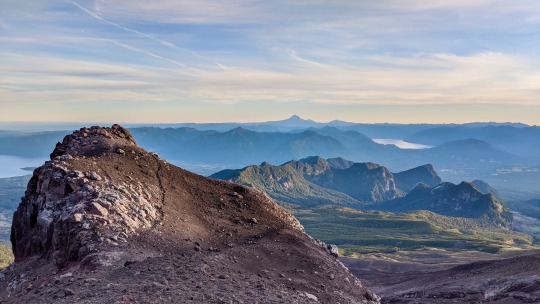
Great views from the start
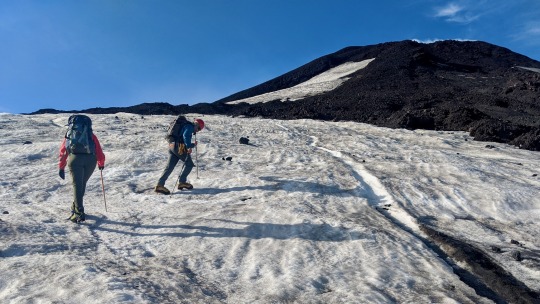
Zig zag
The glacier wasn't as nice as Perito Moreno. It was covered in fine, black particles and there was no meltwater around. Apparently it goes straight under the ice. We still stopped at some impressive crevices though and had some little breaks in between to admire the view behind us. Towards the end the trail became extremely steep and it was more challenging than I thought.

Don't wanna fall into this one

Quite steep
Close to the summit the ice disappeared and we were walking through a rocky environment again. Audrey and I are both quite fast walkers so we were the first ones who made it to the top that day - and what a rewarding walk it was. The views were absolutely spectacular! But looking into the crater itself was also quite astounding. Rust-coloured rocks to the left, sulfur-coloured rocks to the right. Loud roaring from within the crater, gases hissing out of it and what are these funnily structured rocks over here? Oh right, it's the ice from the glacier. It was an interesting world up there with lots of strange shapes to discover at every corner. At one point I decided to put on my gas mask as the wind started to push the smell right towards us. We admired the view - which included a feminist flag that a female guide positioned there a couple of days earlier on International Women's Day - and after 15 minutes we had to make our way down again.

No lava today
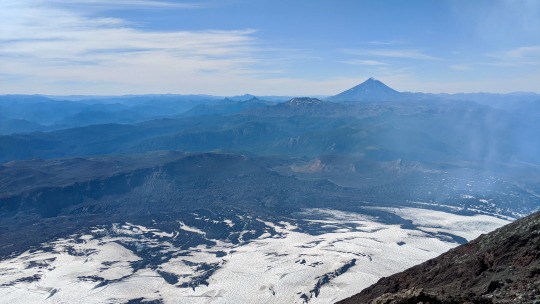
Did I mention the views?
This was an adventure in itself. When we climbed up we could already see some pre-grooved chutes. We were about to use them right now. Both of us were carrying around a little piece of plastic with us. It was now time to get them out and sled down the glacier! I was looking forward to this but it actually turned out to be a bit shit. Because of us walking up so fast, most of the slides were still very icy. I had a lot of trouble breaking with my ice axe and ended up crashing into some of these fluffy rocks halfway through the slide. I bruised my fingers and lost my ice axe but fortunately was still able to stop. The second part was a bit more slushy, so breaking actually worked but I have to say that I didn't enjoy this activity as much as I thought I would. I much more enjoyed the final section of the descent. It was very sandy and we could basically run down sliding our feet through the super fine ground.

Audrey getting ready to toboggan
Back in Pucón we were greeted with some drinks, grapes and cheese which was a nice touch. It was a good opportunity to catch up with our awesome guide Ermin who told us a lot of nice stories about the mountain, the town and how he ended up doing this kind of work. As a side note: Don't ever do a rafting tour when you're in Pucón. Apparently the guides are extremely underpaid.
For the following days I tried to find something that would bring me away from all the noise in the town. My first try was a little overnight kayak trip on one of the surrounding rivers. I quite enjoyed the kayak thing I did in El Bolson but unfortunately they didn't have enough people to do it.
My second option was to rent a car and drive 2 hours up to Conguillío National Park and do some hikes. I already had an eye on rental cars a few days before I arrived in Pucón. Apparently Hertz had a branch in town and when I checked, they always had cars available. The day I was finally ready to book, they didn't have any anymore. I thought this would be because it was quite short-notice now, so I decided to go to the branch directly and just ask. It turned out that the branch actually doesn't exist. Standing in front of the address I found a... craft shop. When I did a bit more research I noticed that I wasn't alone read some fascinating stories. Some people actually booked a car online, went to the non-existent branch and were later fined by Hertz for not picking up their vehicle. It's a mystery to me how something like this can happen to such a well-known global brand!
I wasn't ready to give up just yet and found another car rental in town. But when I checked out their fleet I only found some very old and small Suzukis - highly doubting they'd make it through 100 kilometres of gravel. That was the point when I gave up on option number two and decided to just head up to Santiago to sit down and think about what I'd do next.
The volcano wasn't the last and only activity I did in Pucón though. On my last day, Audrey and I decided to head to El Cañi, a little conservation area where you could find the infamous monkey puzzle trees that grow in the area. The seeds from these trees are sold everywhere in the streets of Pucón and unfortunately I missed to try them.
We did a little hike that I didn't have any expectations about and it turned out to be quite nice. After a super steep and slippery ascent over an old logging road we found ourselves in a beautiful lush forest, surrounded by a surprising amount of bamboo. Towards the end we also finally saw heaps of monkey puzzle trees and walked a little circuit that led us to seven different lagoons. It felt a bit like an enchanted forest - also because we got lost once, ran into some stinging bush and became very confused by the marks more than once. But we also met two cute puppies at one of the lagoons which made up for everything.

Monkey puzzle trees

More of them
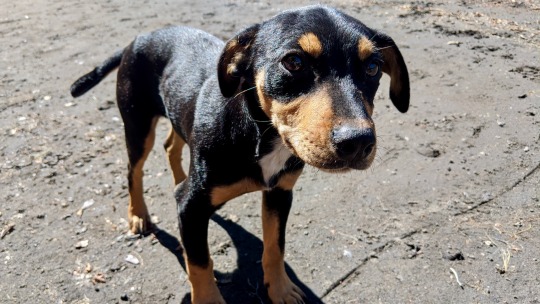
Puppy!
I wasn't super keen on this walk but I'm thankful that Audrey convinced me to do it. It was a great way to escape the hustle and bustle and be out there in the quiet nature for a day.
You all know what happened then after I took the bus to Santiago. On the first day I was still optimistic and explored the city a tiny bit. My hostel was very close to the centre of the civil protests and I actually experienced these a little bit because my first night was on a Friday - the day the protests take place. The whole evening there was a lot of noise outside with firecrackers going off everywhere. We even had a pepper spray grenade being thrown into the yard of my hostel. Quite intense but I don’t think I was in danger at any time.
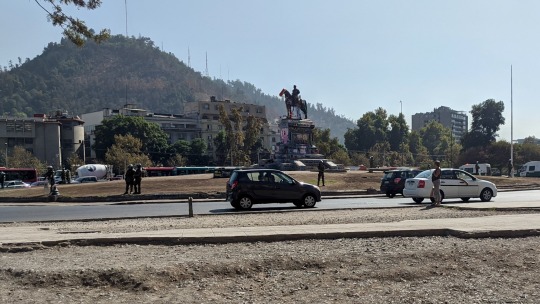
Police getting ready
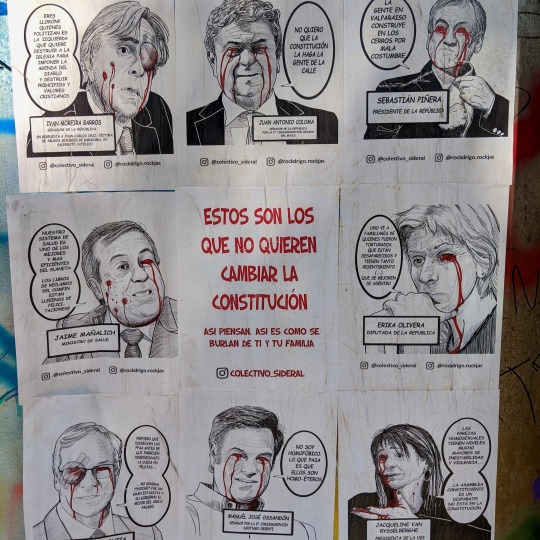
I don't think they like their government very much
However, I mainly wanted to use the time to research what I’d do next, but instead I researched COVID-19 and made the very spontaneous decision to abort my trip. A couple of days later, Chile decided to close all their borders and the whole of South America is in a state of emergency now. I have heard a lot of stories from travellers who decided to stay and are now being kicked out of their hostels and moved around by the police. Sounds like I made the right decision.
In the next few days I'll write a few more articles about some other random things. Hopefully one day I can continue travelling through South America and bring this blog back to life.
0 notes
Photo

Back in Melbourne - moments before Chile confirmed that they will close their borders in all directions. Very happy to see the flying kangaroo!
1 note
·
View note
Text
I’m going home
Today I have made a very tough decision: Due to a world that is going completely bonkers, I have decided to abort my trip and fly back to Melbourne next week.
I have absolutely no idea if this is the right call but I was looking at the numbers the whole day, did tons of research, spoke to friends and family and it all led me to this point.
It started with an innocent little email from Choice (Australia's consumer organisation) that I found in my inbox this morning. The subject was Update on COVID-19 and I clicked on a link labeled What does this mean for travel insurance?. That's how I found out that my travel insurance doesn't cover me for pandemic events, no matter if it was known or unknown the moment I purchased it. That fact alone was slightly mind-blowing (🖕). By the time I bought this insurance, I didn't even know what a pandemic event is. Brushing the thought away that I'm even at risk of an infection here, I still decided to double-check.
It turned out that the virus has now well and truly arrived in pretty much every country in South America. The numbers are still very low, but they were also low when it all started in Italy. And they are in fact a little worse. One thing led to the other and soon I was deeply buried in figures, charts and all sorts of articles.
To be absolutely clear: I am not concerned about the virus itself. I don't think it would affect me very much given my health condition, age etc. What is concerning me is how it’s being dealt with. These are the main reasons why I decided to cancel my trip and go back asap:
1) I don't belong here in times of crisis I am assuming that the virus will hit countries down here in a similar way as it did in Europe. This can be totally wrong but nobody knows. The numbers unfortunately speak against it.
We are all seeing how Europe reacts: Borders are closed, countries are locked down, health care systems are overwhelmed, economies go crazy. People in South America like a little riot (there is one close to my hostel right now) and I simply don't want to be here when politicians take these actions. I don't speak the language, I'm not part of the population, I don't have a place in their health system - I'm just a stumpy, snobbish tourist on a 3 month visa. What if they close the country and my visa runs out? What if the economy breaks down? The risk for a crisis is high and I simply shouldn't be here when it happens. My social network is elsewhere and that's where I should be.
2) It’s also a matter of respect As I wrote before, I'm not overly concerned about the virus itself. Even if I'd get it, I'm super confident that I would have only mild symptoms and can just move on. I'd still be a carrier though and can infect people who live here. In my opinion it would be a bit selfish and ignorant to continue travelling in times like these.
This article convinced me that social distancing is the best way to save at-risk groups and if I continue travelling I would definitely not do that. People in South America have close social interactions. Families living together in small spaces, hell they drink mate out of the same straw. I should not put additional pressure on fragile health systems only to look at a few mountains and beaches that will still be there in a couple of months.
3) South America doesn't go anywhere This one is a bit tough because this trip fits so perfectly into my life at the moment and I still had so many things to see. Also I just got into the right rhythm and felt really good with my travelling style. But that's arrogant. I can always come back. Maybe not in a single trip. Maybe not tomorrow or next month. But this continent won't just disappear anytime soon.
4) In the worst case scenario I'm not covered This is only the icing on the cake but if things go haywire I'm only covered by Medicare in Australia at the moment. And I'm talking about the really bad scenario with me getting a pneumonia or something. And for various reasons I really don't want to experience this down here.
I don't feel great with this decision, especially because I'm still very much torn about the way we deal with this virus. But there are some hard facts that won't go away and one is how governments deal with the situation worldwide. I don't want to be stranded here, that risk is just too high. Am I overreacting? Am I panicking? Maybe. But the decision is made.
😢
1 note
·
View note
Photo

My spanish is bad but I think these people are still angry
3 notes
·
View notes
Photo

Strong message on top of a powerful mountain
7 notes
·
View notes
Quote
Every time, I think I'll go hiking and sort out my life problems, but you just look at the views and try not to trip over.
😂
0 notes
Text
Lost in heritage
When I put Bariloche and the surrounding Lake District on my long list of things to do in South America, I wasn't really sure what to expect. I had read about some nice lakes, beautiful mountains and a bit of Alpine-style architecture but what I found when I got here was pretty much... Germany. Just in Spanish. Okay, there might be some more minor differences, but I'll get to that later.
In terms of accomodation, I got a lot more lucky recently. For Bariloche I picked a place that was supposed to be a little bit outside of the city centre which I thought would mean quiet. However, it turned out that from Bariloche you have one busy main road that goes all along the huge Lake Nahuel Huapi and never really becomes quiet. The hostel was still an awesome choice though: It was small, the owner was super caring and best of all they had Alan - a chef who cooks an amazing three course meal every night for little money. During my four day stay, the other guests were also very nice and did not stare at a black mirror the whole day.
When I arrived, Alan immediately overwhelmed me with all the hiking choices you have in Bariloche. You can probably spend at least two weeks just with hiking. Conveniently most hikes are accessible by bus, so you don't even need a car. The first thing I wanted to do though was to buy a new rain jacket. So off I went into the city centre. And I bloody hated it. Bariloche is super popular as a vacation spot for Argentinians and they really try to squeeze every last cent out of you. At every corner you have shops where they try to sell you all sorts of shit that you don't need. You can book skydiving, rafting, canyoning - pretty much everything that you can do everywhere else, too. It was noisy, it was busy, I left it very quickly again without even getting my rain jacket. But not before having some amazing ice cream at a place called Rapanui though - there's got to be time for that.
The next day I wanted to mix things up a little bit after spending so much time with hiking before. When you follow the main road all the way to the end, you get to Circuito Chico: A 27 kilometre loop that goes past some short hikes, beaches, breweries and other smaller sights. Sounds like a perfect bicycle trip to me! After renting a two-wheeler I explored the area for the day. It was very sunny and hot, so I actually ended up just cycling from beach to beach to brewery and didn't do any of the hikes. I also took one of the famous chair lifts in town to get to one of the lookouts that gives you the view. When I spoke to Corinna recently, we agreed that pretty much every view in Bariloche is the same anyway. You see the surrounding lakes, mountains and forests and it doesn't differ much at all.
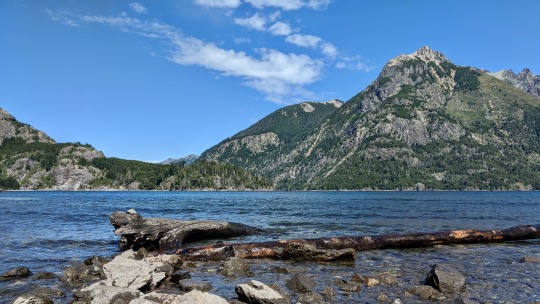
Good place for a nap
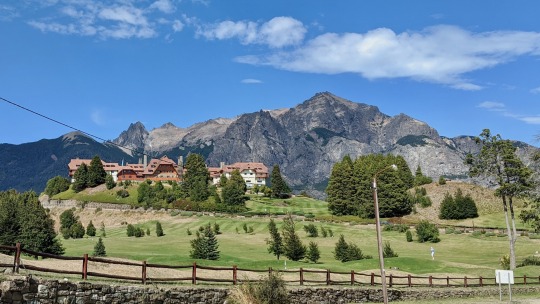
This looks familiar
I wanted to do at least one day hike while I was in the area though and after looking at all my criteria (accessible by bus, something with water, nothing that just gives you the view) I decided to tackle the 25 kilometre return hike up to Refugio Frey on day two. As usual, I started early to avoid the crowds. The hike itself was quite dull and uninspiring. It was also extremely dusty which actually turned out to be the case for all hikes in the Lake District. But what waited at the end was definitely worth it. There was a beautiful little lagoon, surrounded by an amphitheatre of spiky peaks and of course the Refugio itself which sold cold drinks. I spent a couple of hours up there, basking in the sun and just enjoying the scenery.

Spiky peaks
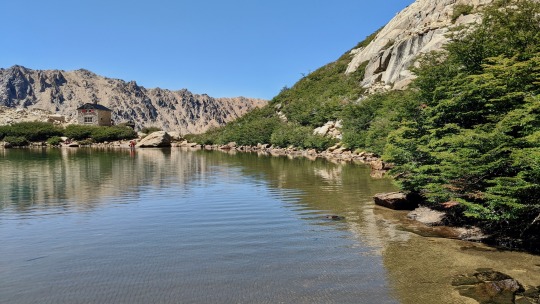
Great place for a refreshing dip
Now - I originally wanted to leave the German part until the end but I have to bring some aspects of it forward a bit because it fits into the current story. The whole area here basically looks 100% like South Germany/Austria/Switzerland. And not just the landscape, also the architecture (which is due to some immigration waves from Germany, some of them quite questionable). The hike to Refugio Frey started at a chairlift and in the morning I didn't really pay much attention to it. But when I came back down, I had to wait 45 minutes for the next bus and suddenly I found myself in the most bizarre situation. Trying to kill some time, I went to a little Kiosco for a cold drink. I sat down and the following happened (watch with sound!):
youtube
Where the fuck am I?
What. The. Fuck. Look at the scenery. Look at the architecture. Listen to the fucking music. This was probably the most German experience I ever had outside of Germany and it was just plain weird. For a moment I actually wanted to leave the area. This is not why I'm travelling. Why go to Argentina for something that you can actually 100% have in the country you grew up in? But to be fair: I like summers in Germany, I like freshwater lakes, I just had to change my attitude. This is beautiful and I should just enjoy it. It doesn't matter where I am, it only matters that it's nice. Well, maybe not the music, but the conditions, the setting, the water. Let's move on.
For my last two days the forecast was mainly saying two things: Hot and sunny. I surely didn't want to walk in the dust with these conditions and luckily I was surrounded by beautiful water everywhere. So I decided to book a little trip to a place called Isla Victoria - famous for its white beach. During the trip we also stopped at another island to look at some Myrtle trees that apparently inspired Walt Disney to make Bambi (he scotched this rumour at some point) but I was only interested in the beach. And when we finally got there, we had four hours time for it. I headed straight to the fine gravel and also for the first time in six weeks went for a little swim. How much I missed this! I'm totally out of shape but it felt good to just move in the water again. Water temperature was also quite ok with about 16 degrees close to shore.
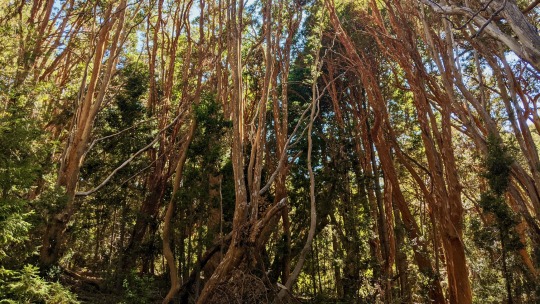
Bambi trees
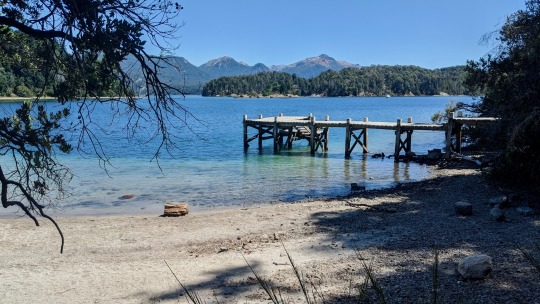
Please sun, turn me into a crab
On my last day, a thing called triathlon thwarted all my plans. Three wonderful girls (one of them having her own bikini brand, just saying...) and I wanted to spend the day at Lago Gutiérrez. That lake is apparently the warmest lake in the region because it's fed by rain water and not glacial water like the other ones. I was hoping to use that opportunity and do some more serious swimming again but unfortunately there was an Iron Man that day and half of Bariloche was shut down. On the positive side, this also led to a closure of the main road in front of the hostel and it was super quiet that day. We ended up walking a few kilometres up and down that road until we found an acceptable place close to the water where we ended up just chilling in the sun.
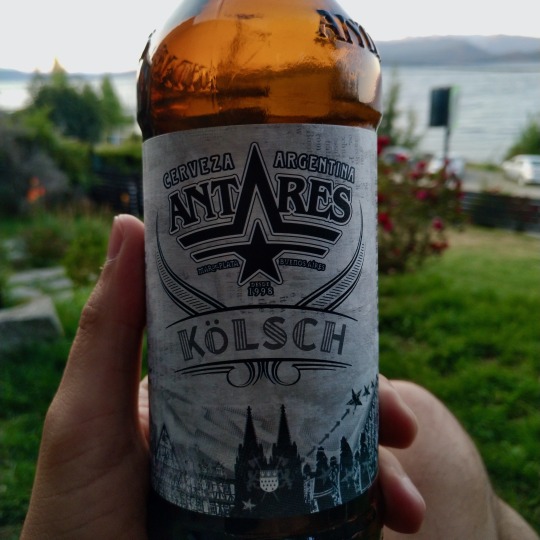
They even put in the Dom and the coat of arms!
It was now time to leave Bariloche, but I wasn't done with the Lake District yet. A lot of other travellers warned me about the fact that Bariloche is quite busy and recommended a little town called El Bolson, which is roughly 2 hours south. I was in desperate need of something quiet and found the perfect place: A hostel called Luz Clara which was even further south in a village called El Hoyo. And this was an absolute lucky find.
The hostel is located in a rural area and after leaving the taxi I felt instantly relaxed. It was surrounded by a huge garden, with hammocks between the trees and a little creek nearby. The style was very rustic, beautifully made and it was an absolute haven compared to all other places I had stayed so far. Juan, the host, and four volunteers run the place and they're doing such a great job. One of the volunteers was a vegan chef and made some incredible meals for all the guests one night. They also set up a cozy fire every night and it was just perfect to abandon oneself to total idleness. For some reason however, I still ended up doing something every day...
There was a surprising amount of things to do in the area and I started slowly on day one with just a little 10 kilometre hike to a waterfall. It was still quite hot during the day and I ended up dozing in front of it with the cool spray from the falls breezing into my face.
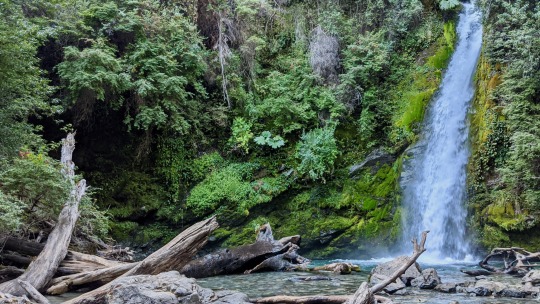
Another pretty waterfall

Stretched up even further
On day two I wanted to do a kayak trip on a lake which came highly recommended by Juan. They wanted to pick me up from a road close to the hostel at 10:30am but after waiting for an hour at the end of a dusty gravel road, I decided to go back. Juan was shocked when he heard what happened and felt super guilty. So he spontaneously organised a hike to a secret lagoon with two of the volunteers which turned out to be quite adventurous. He warned me about that though:
You might be disappointed. You might even be a little mad. But it will definitely be an adventure.
I don't think he knew how correct he would be with that statement. We wanted to start at 3pm which would have given us plenty of time to get back before sunset. But Juan's new hobby didn't agree with our schedule. He bought a Jeep from 1960 a couple of weeks ago and likes to tinker with it and learn stuff about cars in his free time. For him it has the same effect as meditation and I can deeply relate to that. Unfortunately the car wouldn't start when we wanted to leave which was due to a cable that got disconnected as a result of heavy corrosion. We had to start the car manually which meant that one person had to hold the cable and make sure it touches the contact point. I thought some of the wiring in our old Nissan Patrol was dodgy but what I saw under the hood of this car was just... impressive. About 30 minutes later we were finally on the road. When we were passing the local supermarket, Juan decided to stop for some snacks. What a fatal decision. We tried to start the car manually again but Juan didn't put it in neutral so it basically jumped forward a bit with two of us leaning over into the hood. Thankfully nobody got hurt but that little jump caused a new issue. The whole electrical circuit was now interrupted, most likely a contact that became loose during our attempt to start it. I learned a thing or two when I was tinkering with the electrics on our car in Australia and I suspected that the main battery got disconnected. The wires there were dusty as fuck and heavily corroded. Juan's phone didn't have service so he had to walk a kilometre to find wifi. He called a friend of him who was a mechanic and about thirty minutes later he arrived. It turned out that I was right. He rewired one of the main cables that went into the battery and we were able to manually start the car again. It was 5:30pm by now and we decided to still do the hike.
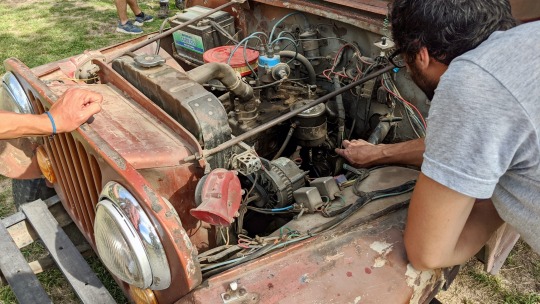
How do we fix a car that’s twice as old as us?
Juan wasn't exactly sure where we'd have to start the hike but he was optimistic that we'd find the trail if we just follow the random forest roads that led up the mountain to the lagoon. It was super dusty again with my shoes completely disappearing in piles of dust at times. The poor people walking at the end were breathing in a lot of that dust which is why we decided to take turns. After zigzagging through the forest, we finally made it to the trail. Parts of it were overgrown and we had to take some bizarre detours but eventually we made it to the lagoon. It wasn't anything special but we were definitely the only ones and it was a good change compared to most of the other hikes I did in the past few weeks.

The lagoon
After walking through that dry and dusty terrain for more than 1.5 hours I was craving to get into the water. It turned out to be quite difficult though as it was surrounded by reed and mud. The others pulled out but I didn't want to give up. Getting in would be easy, but how would I get out again? I decided to place some branches into the mud which would hopefully act as some kind of path for me to get out. It kind of worked but I was still knee-deep in mud when I tried to go back. The water was beautiful though and it all added to the adventure. Once I was out, I constructed a little brush with a Spinifex kind of grass so that I could clean my legs. Eventually it all worked out!
Once it started to get dark we made our way back down again. We weren't sure where we would end up once we were down that mountain and we actually made it into somebody's backyard. Thankfully the people who lived there we very easy-going and pointed us in the right direction back to the car. We were able to start it without problems this time, the only minor thing that happened was a blown fuse once Juan turned on the lights. That was an easy fix though and half an hour later we were back in the hostel. What a beautiful day!

Nice sunset on the way back
Once we were back in the hostel, we also heard from Pedro - the guy who was running the kayak tours and was supposed to pick me up in the morning. It turned out that he had some logistical problems in the morning and simply forgot to pick me up... he was very, very apologetic though and I decided to give it another go the following day.
The next morning he was actually 10 minutes early and picked me up right in front of the hostel. He apologised another million times and I had the feeling that he was genuinely sorry. Plus he was driving a Hilux, how can you not forgive a Hilux owner? After picking up all the other people (we were about 12 in total) we made our way to Lago Epuyén. Pedro was happy to give me a single kayak and even removed the rudder as I prefer to keep it simple and steer my watercraft manually. After giving everyone a crash course in paddling we started our little 12 kilometre cruise.

Crystal clear water
Being on the water I immediately noticed a key difference to most other lakes I've been on. The water was extremely clear and had a beautiful deep blue colour. I assume this is due to the colder temperatures which simply doesn't allow algae to build up that much. About 4 kilometres in it was time for our first stop. We parked the kayaks on a nice beach and Pedro prepared lunch for us. He sizzled some beef on a hot plate, cut some fresh veggies and we had some delicious sandwiches. We then hiked up a little hill to a scenic lookout with a great view of the lake.
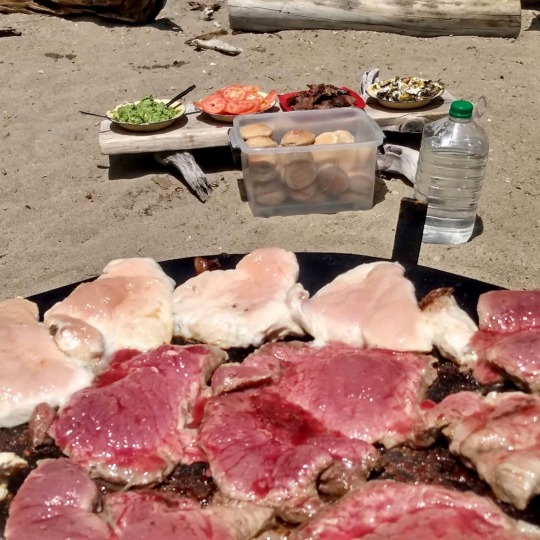
Lunch anybody?
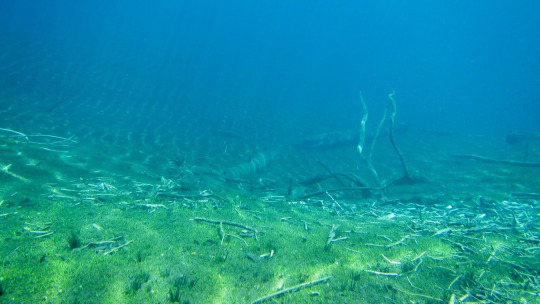
Underwater

It was a calm start to the day
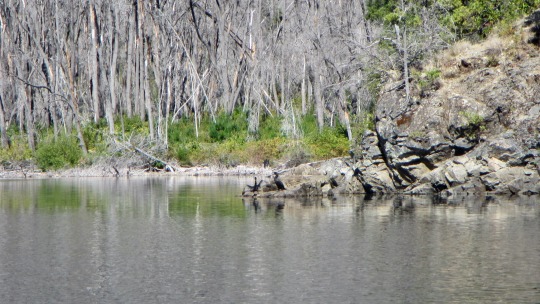
Some wildlife
I was the only non-Argentinian in our group by the way and even though everybody mostly spoke Spanish, the others really made an effort to include me in the group. Their English was really poor but with the few words they knew (plus hands and feet) we were able to actually have some good conversations.
After our excursion to the hill we got back into the kayaks and paddled another 4 kilometres to the next pretty beach with a little waterfall on the side. After recording a superhero rock jumping video it was time for some Mate and scones with homemade jam from Pedro's mum. I got another lesson on how to make Mate and I have to say that I'm damn close to buying my own Mate set. It took me a while to warm up to it but I'm definitely a fan by now. I think it's time for the dedicated Mate blog post very soon.
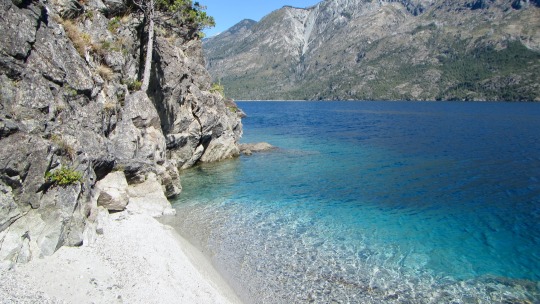
Look at these colours
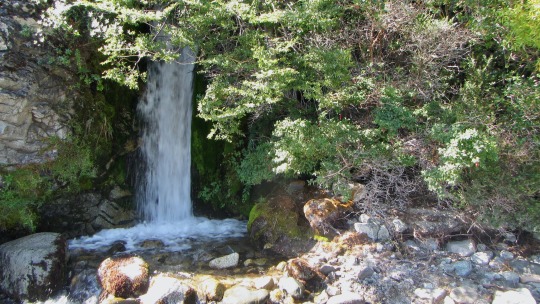
Shower
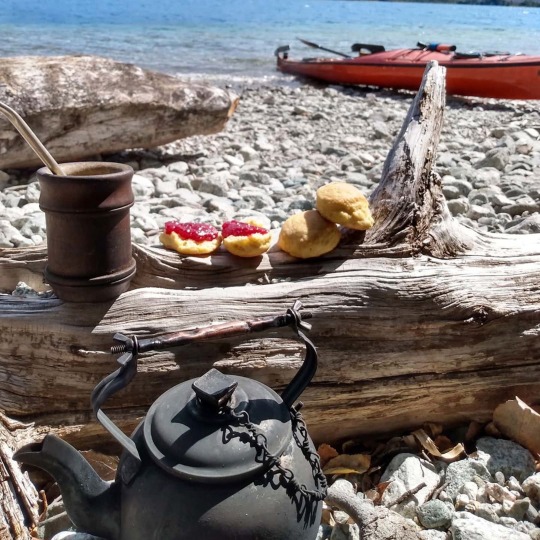
Perfect afternoon snack
youtube
Guess what superhero I tried to be
The last 8 kilometres back to where we started were a little more challenging due to some headwind, but we all made it back safe and sound. It was another beautiful day and a refreshing change to all the dust that I encountered on all the hikes I did before in this area. Originally I was planning to do the popular Cajón del Azul hike but I think this was a better choice. Water beats soil - always.
The next day was a travel day and brought me to a town called San Martín de los Andes from where I'm writing this blog post right now. It's quite a posh place but I'm only here to relax for two days before making my way back to Chile again. The landscape is pretty much the same as in Bariloche and El Hoyo. When I started writing this post I realised that I actually didn't take any pictures of the Alpine-like architecture here in the Lake District in order to proof my point that it looks so much like South Germany. But then I thought that I'd probably just have to walk a few blocks to find some good examples and it turned out that I was right:

Cake shop
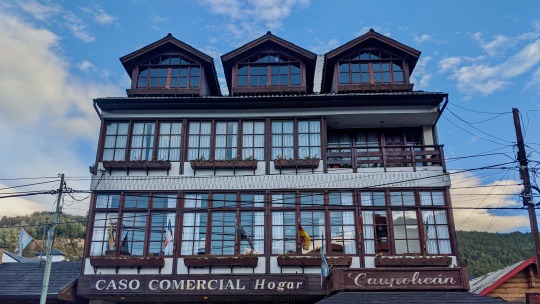
Hotel

Downtown
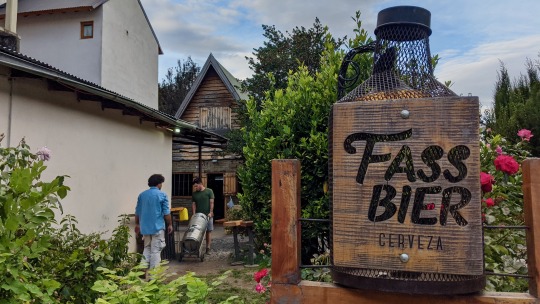
Pub
One more thing I'd like to briefly mention is my progress in terms of eating my way through the Argentinian cuisine. Hopefully this blog won't turn into a foodie blog. I'm not an expert when it comes to food anyway but these guys here surely know how to cook. During my time in El Calafate, I went to a place called Isabel where they served stew-like dishes, served in a cast iron skillet. This might have been the best frigging lamb I ever had. Also Alan, the chef in the hostel in Bariloche, made an Asado one day and I can confirm that the Argentinians are at least as good as the Brazilians when it comes to BBQ (sorry Will!). He also made a delicious vegan bowl for us one day and I'm very close to liking vegan food by now. For me, vegan always translated to dry and tasteless but Alan and the volunteer from the hostel in El Hoyo (forgot her name) proved me wrong.
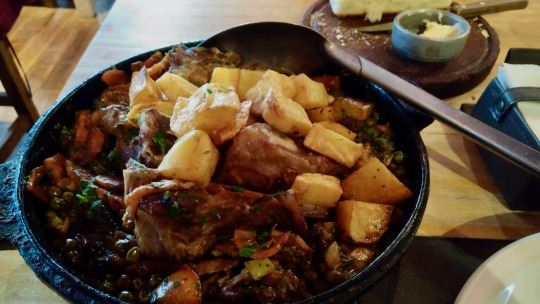
That’s what I call a proper portion of lamb
All in all it was an interesting time here in Northern Patagonia. I don't think it's specifically worth going when you are from Europe, but if you're in the area anyway and just travelling through it's surely worth stopping because it is still beautiful. Also, when speaking to people who were from Germany and Switzerland, they still pointed out a few differences (the colour of the water, the more ranch-like environment). I'm just happy and grateful for my time here. I've met some great people, did some amazing little trips and I'm now looking forward to climbing an active volcano in Pucon before leaving Patagonia and exploring some totally different environments again up North.
0 notes
Photo

Another beautiful day on the lakes of German Argentina
3 notes
·
View notes
Photo

30° and this. I’m not hiking anywhere today.
0 notes
Text
Blue
After a bit of a zig zag route through southern Patagonia I eventually found myself back in El Calafate. One thing I still wanted to do was to go and visit the Perito Moreno Glacier, which is just 80 kilometres out of town. I've never been on a glacier before and after discovering my love for these bodies of ice during the O circuit I was very much looking forward to this.
Warning: One million pictures ahead.
Perito Moreno is quite popular for three main reasons:
It's super easily accessible
It's one of the few glaciers on earth that is not retreating
It hits the mainland on a regular basis, building an ice-bridge as a consequence which eventually collapses spectacularly

Walls of ice
There are a couple of options how you can explore this beast. The simplest way is to just take a bus and observe it from the balconies that have been constructed right in front of it. Boring. Another idea is to do a little boat trip which gets you a little closer to it but is basically just another cruise. Also boring. What I found a bit more interesting was the idea to kayak in the waters around the glacier which would allow you to get up close with all these mini icebergs that float in the lakes. Unfortunately this could not be done in a single kayak. Given that kayaks with multiple seats are one of the worst inventions ever, I quickly ruled out that option, too. What I ended up doing was a little hike.
Two hiking tours are being offered: A “mini-trekking” option, which is basically just a one-hour walk at the front of the glacier and a “big-ice” option, which is a three and a half hour hike a few kilometres into the glacier. Both would also include a visit to the balconies and a little boat ride through the lake.
The big-ice option is (again) advertised as being physically demanding, strenuous, yada yada yada. Spoiler: It's not. It's a bloody walk up a little hill, then you put on some crampons and walk up and down a few more little hills only this time they're icy. No big challenge at all.
But let's get back to the tour. I was lucky with the weather! It was a mostly sunny day and most importantly not too windy. Once we entered the National Park I felt like a child on Christmas. After every corner I was hoping to get a first glimpse of the glacier but it seemed to drag on forever. But eventually I was able to spot these 70 metre ice walls towering out of Argentino Lake. The ice itself is actually 170 metres high by the way. It is touching the ground and not floating on the lake like some other glaciers do.

I thought this whole rainbow thing would be special - it's not

Not only the glacier was a looker
We had about an hour on the balconies and this hour alone was already worth the trip. It looked as majestic and beautiful as on the pictures but another element that added immensely to the experience was the sound. You could constantly hear ice cracking, crumbling away from the walls and hitting the water. I was lucky enough to video tape a larger piece of ice as it fell into the lake.
youtube
None of the voices are mine
After that hour - which felt way too short - it was time to start the main activity. A 20 mins boat ride later, we made our way up a hill on the side of the glacier. You could already hear an enormous volume of meltwaters making its way down on the side. That meltwater also acts as some sort of lubricant that helps the glacier to move forward. Another hour later we put on some old school crampons and carefully entered the glacier. From that moment on we were captivated in a totally different world that got better and better with each step. If you've ever seen the movie Chasing Ice, it was exactly like that. Well, maybe a little smaller.

They were as uncomfortable as they look

Off we go

Waterfall anyone?

Ice cave
On every corner one could discover an incredibly blue water hole, a fascinating deep ice crack, a weirdly shaped cave or just a wonderful stream of meltwater, carving little canyons into the surface. And then there were all these little rocks that the glacier sucked up centuries ago. Some of them could be seen deep in the ice when looking down a water hole. Absolutely breathtaking. Oh and did I mention how much I love the taste of the water here? That glacial water was no different. What a treat!

Just a little crack

Didn't really have to chase waterfalls here

Cracks, water, blue - you know the drill

Is it a waterhole? Is it a stream?
For the next three and a half hours we basically just walked up and down the ice. On the outside, the ice was actually so rough that it was super easy to sprain an ankle. But the deeper we got into the glacier, the finer the ice and the easier it was to walk on. I don't know what else to say, my jaw just dropped more and more with each step. And before we knew it, the time was already up and we were on our way back home... but not without farewelling in style with a whiskey on Perito Moreno ice.

More blue, more waterfalls

A stream in front of a little cave - and some random rocks

Yep, the scenery was ok

To me!
I can absolutely recommend this experience and I would definitely do something like this again. All these different shades of blue, incredible ice shapes and unfamiliar sounds added to a birthday experience that I will surely not forget too soon.
0 notes
Photo

Yep, definitely getting that Swiss vibe here
0 notes
Photo

Blue almost became my new favourite colour today
2 notes
·
View notes
Text
The definition of wind
Let's see what Google says when you search for a definition of wind:
Wind is the perceptible natural movement of the air, especially in the form of a current of air blowing from a particular direction.
My definition so far has been something like this:
Wind is when your clothes are flapping in the air and it's generally harder to move forward.
Now, after hiking the O circuit, this is my new definition:
Wind is when rain covers detach from high-quality backpacks, rain jackets rip apart, people blow over like sandwich boards and experienced hikers crawl on all fours in a desperate effort to move a little forward.
And whilst I've literally been blown away in the last 8 days, figuratively I'm not.
Let's start with a look at a map. The O circuit and the W trek are multi-day hikes through the Torres del Paine National Park. Most people do the popular W trek which usually takes 3 to 4 days and can be walked in both directions. The W trek is also part of the bigger O circuit which can only be walked in anti-clockwise direction due to the windy John Gardner Pass. The O circuit usually takes between 7 and 10 days and is considered to be a bit less crowded due to a limited number of permitted hikers in the Northern section.

How the O and the W are connected
When researching the O circuit (or "the O") I found lots of different descriptions, but most of them included words like "challenging", "demanding", "rewarding", "remote" and "breathtaking". Obviously this caught my attention and soon I was in the complicated process of trying to book campsites along the trail. This turned out to be quite difficult and the fact that the camps are managed by three different organisations that don't talk to each other didn't make it any easier. Then I stumbled upon an alluring offer: Pay someone to book all campsites for you, have the tents already set up and be fed in the mountain huts (or refugios) along the way. Given that I wanted to enjoy Mother Nature as much as possible, I like minimalistic travelling and I had some cash at hand, I decided to take up that offer. The only downside was that the first part of the hike would be guided and I expected that this would cause some issues due to different walking paces. At the same time it's always nice to have someone that you can ask questions about flora, fauna and the history of the park.
Fast forward I found myself in a great hostel in Puerto Natales - the closest town to Torres del Paine - packing my 24 litre daypack for the big trip. Some people found it hard to believe that I'd do the O with this little backpack, even though I didn't have to carry a tent and food. And everybody else from our group had at least a 50 litre pack. But I can already spoil that it worked perfectly fine. Seriously, you simply don't need so much stuff, you just need the right stuff. This is all I took:
Sleeping bag (5° and I should have taken a warmer one)
2 breathable shirts as a base layer (wearing one)
Fleece jacket
Insulated jacket
One pair of convertible, water-resistant hiking pants (wearing)
2 pairs of Merino wool socks, one thick, one thin (wearing one)
2 pairs of Merino wool undies (wearing one)
Rain jacket
Windbreaker
Beanie
Bush hat
Buff (one of my most valuable pieces of gear, it's so ridiculously versatile)
Waterproof gloves
Camera
A big, big power bank
Kindle
Sunnies
Toothbrush
Toothpaste
Deodorant
Small soap bar
Small towel
Insulin pens
Glucometer
Glucose tablets
A few protein bars
Headlamp
Inflatable solar lantern
Flip flops
Water bottle
Steripen
The key is to have clothes that are quick-drying, breathable and have as much Merino in it as possible. People might be grossed out by the thought of wearing the same underwear for multiple days but it really isn't a problem. Merino wool is antibacterial and it takes ages for it to smell, it is perfectly fine.
Let's move on to the actual hike: Our group consisted of five people and our infectiously cheerful guide Debbie. The other four were Gail & Alisha from England and Julie-Dodd & Marie-Laurie from the States. Walking pace was definitely an issue from day one. Gail and I were the fastest walkers, Alisha a little in between, Julie-Dodd and Marie-Laurie were the slowest. We never really got into the same rhythm as a group which turned things into a bit of a stop-and-go activity for me. But as I said before: I expected this and could live with it.
The first three days were generally a bit unspectacular. The trail was fairly flat and we mostly walked along some beautiful coloured rivers & lakes through picturesque valleys. Things got a little more interesting on day three when we started to see a few glaciers in the distance which gave us a first taste of the famous Southern Patagonian Ice Field. Wheatherwise it was fairly sunny on day one but it became gradually more cloudy and windy. We also had a few periods of rain and the mornings were quite cold, so all layers of our clothing were used all the time.
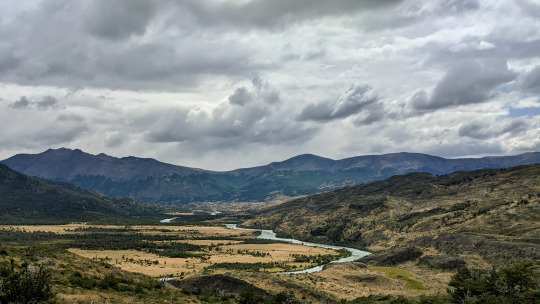
Paine River

Paine River
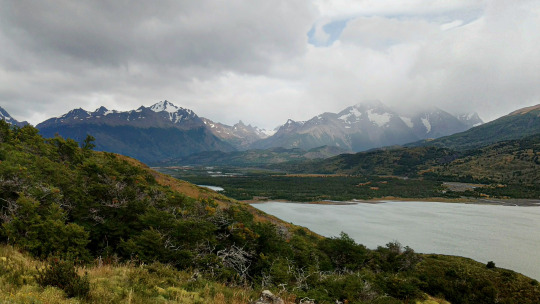
Mountains that separate Chile and Argentina
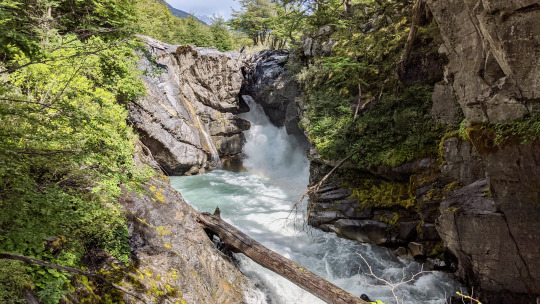
Did I mention that I like a good waterfall?

Lago Dickson
The wind was particularly strong on the lookouts. To our amusement, one Canadian couple put it quite nicely when we got to a point where I didn't want to pull out my camera because I was concerned the wind would take it. The girl was yelling to the guy:
This is not a good place to make a sandwich.
This line became a running gag for the rest of the trip.
At the end of day three we got up close to a glacier for the first time and the wind picked up again noticeably. Debbie told us that the next day would be quite challenging: Fierce winds and lots of rain was forecasted and there was a high chance that the John Gardner Pass - which we were supposed to cross - could be closed. She suggested to start early. Not only did we have to hike 1,200 metres up, we also had to hike about 22 kilometres to our next camp.
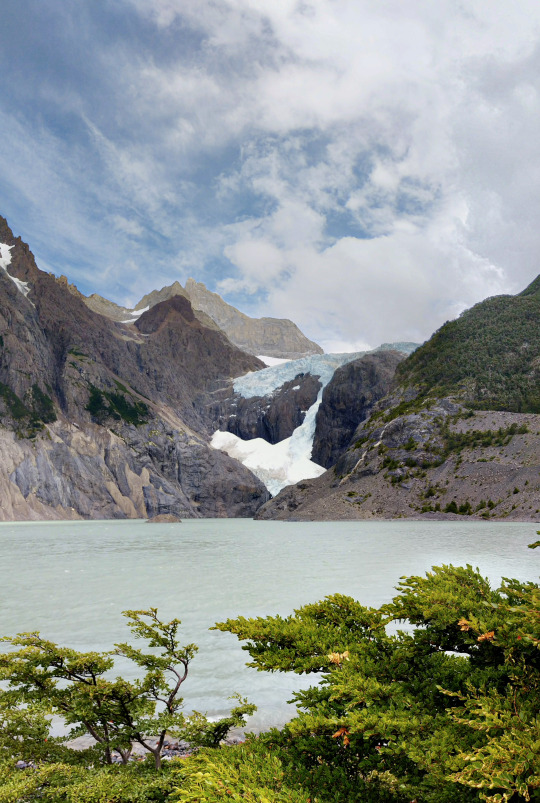
Glacier Los Perros
The host of the refugio overslept, so after a very sparse breakfast we hit the trail at about 5am. It already started raining and we spent the first hour walking in the dark through a muddy forrest before getting to an exposed & rocky area above the tree line. The rain turned into a mix of hail and snow and the wind pushed us all to the limits. It was here that the first rain covers flew off and people started being blown over. Gail, Alisha and I had to take quite a few breaks to wait for the other two to catch up. As a result we became very cold very quickly and Debbie noticed that we simply can't continue as a group. Even though I had my full waterproof layer on, most of my clothes were soaked in water - the rain was simply too much. The only thing that was dry were my hands, so it looks like my gloves are my most reliable piece of gear (a rather unresearched purchase from Amazon about a year ago). My feet were soaking wet and due to the wind chill became so cold that I couldn't feel my toes anymore.
Debbie sent us three ahead and it definitely helped that we didn't have to stop anymore. I wouldn't go so far to say that we were warm, we were just less cold. When we reached the top plateau of the pass we battled a constant stream of 100 km/h wind. It. Was. Unreal. And surely not a good place to make a sandwich...
Every step became a hard push - this wasn't walking anymore, this was a full-on pulling rope exercise. Alisha fell on her knees, all of us were walking bending over trying to give the wind as less surface as possible. Reaching the main pillar I climbed it with a victorious feeling but this thing was far from over. Getting to the other side we had an astonishing view of the Southern Patagonian Ice Field but we had absolutely no time to enjoy it or even take a little photo. I didn't feel my feet anymore and had to start running downhill for about 10 to 15 minutes in an effort to get warm. I reached some shelter behind some bush, the bush turned back into forest, we were finally much more protected and it became a lot warmer now. My toes came back to life and for the first time we were able to properly speak to each other again. There was a sense of achievement in the air, we hugged each other, we felt like we went through something together. At this point Alisha noticed that my rain jacket wasn't in as good spirits as I was: The hood and parts of the upper back got totally ripped apart. The irony is that I thought about replacing it before the trip but I figured it would do it for one more year.
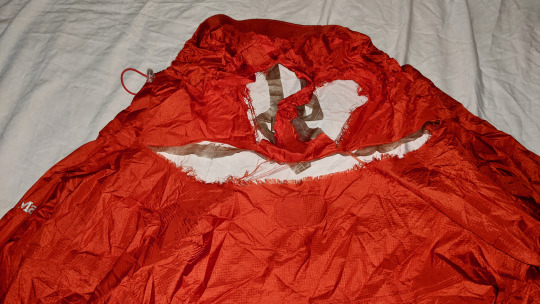
What's left of my rain jacket
For the remainder of the walk, the massive Glacier Grey stayed on our right and we finally had some time to stop and snap some pictures. We had a rest at a ranger station and waited for the others to catch up. When they arrived, they told us their story and apparently they had to tuck their arms into each other and crawl over the pass. Later we heard that the pass was indeed closed a few hours later and the wind gusts were around 120 km/h. Needless to say that this was the bloody highlight of the whole trip. Unfortunately we don't have any photos from this epic crossing, so I really hope these memories will stay in my head for quite some time and Alzheimer's won't get me too early.

Southern Patagonian Ice Field
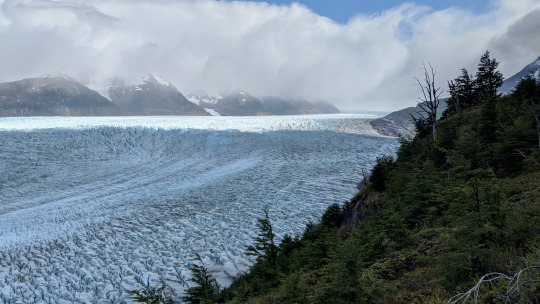
Glacier Grey
To our luck the rain started easing up after the pass and the rest of the day was quite cruisy. We crossed a few nice suspension bridges before reaching our camp for the night. You could clearly feel that we now joined the W trek. It was quite busy and the refugio even had a little café with couches and stuff. I wanted to treat myself with a hot chocolate and realised that all my cash that I took with me was gone. I only used a little bit for a hot drink on day one, after that I didn't take my wallet out again. Which meant that someone must have gotten into my tent on one of the other campsites and stolen my cash. I have to say that it was also partly my own fault. Whenever I arrived at my tent, I completely unpacked my bag and spread everything out for easy access. If somebody opened the tent, it would have been a five second job to take out the money. It is a shame though - the back area of the park wasn't crazy busy and it felt a bit like we were all a big family moving from camp to camp. Debbie was also shocked and it turned out that some other people from other groups had some of their stuff stolen, too. I was way too trusting.
This crazy day was also our last day with a guide: The next morning Debbie would leave us and each of us would continue at our own pace.
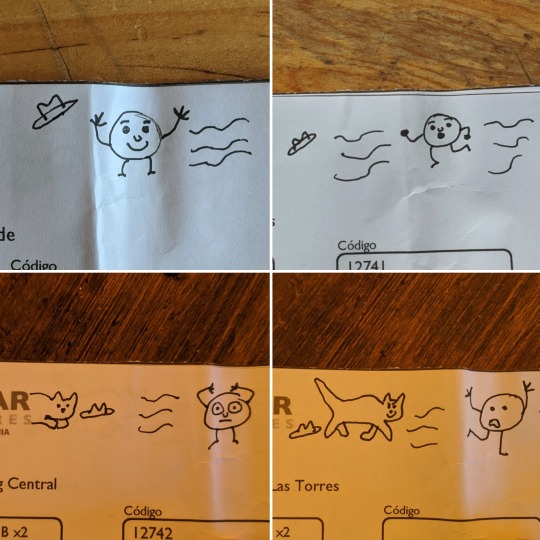
Debbie drew a little comic for me as a farewell
For day 5 I didn't have any high expectations. On paper it did look like a rest day with only 11 kilometres to walk and not many highlights on the map. But it turned out to be quite interesting. Most of the trail led through exposed areas which I like a lot more than forest. There were wonderful views of Lake Grey and the surrounding mountains but it was still super windy and I couldn't stay long on any of the many many lookouts.

Glacier and Lago Grey
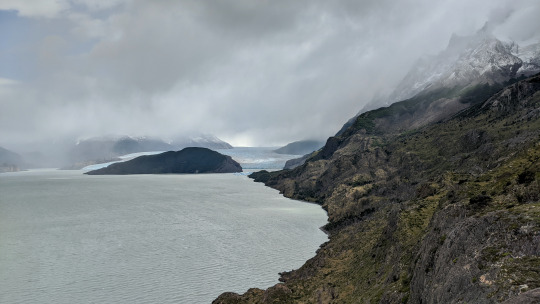
Bye bye Glacier Grey

Hello Lake Pehoe
Day 6 was another big day with more than 20 kilometres to hike. It was the middle part of the "W": French Valley. The first section was quite steep and rocky but the reward was worth it. Reaching the first lookout I had a wonderful view of the valley to the left and the French Glacier to the right. Moving on, the trail became less steep and I barely felt that I was still going up. The second lookout offered another stunning view of the mountains further back. What a lovely little side trip.

Beautiful mountains everywhere
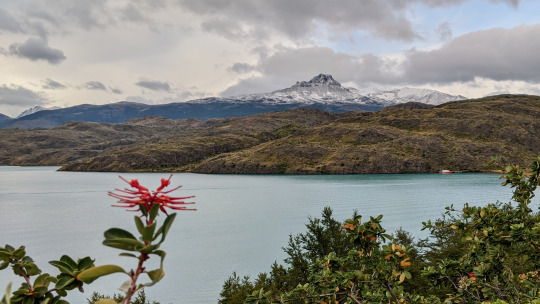
Lake Pehoe
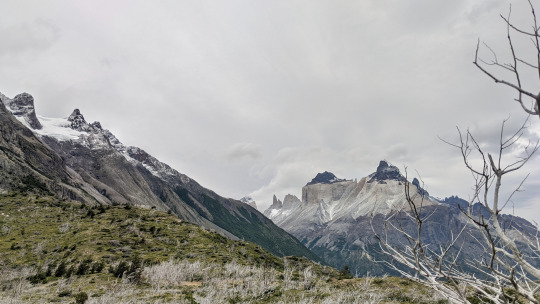
Los Cuernos

French Glacier

Close to Mirador Británico
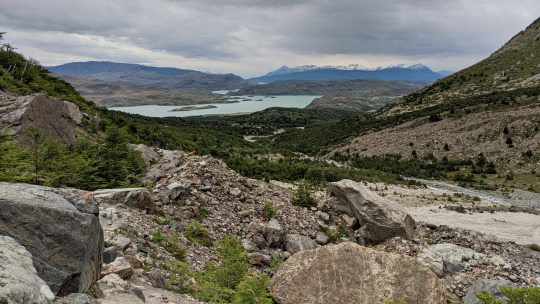
French Valley
On my way back down I stumbled upon Alisha who started the day a bit earlier than I. The one word that comes to mind when having to describe her condition would be kaputt. She had very sore muscles (or a muscle hangover as Germans would say) and as it turned out later also had two gigantic blisters on her heels. I decided to walk with her until we would reach camp trying to support her mentally as much as possible. The five minutes strategy from Snatch didn't work very well by the way.
To our surprise the trail was leading down to one of these wonderful glacial lakes and we even walked along its pebbly beach for a few metres. We ended at my favourite campsite of the trek (Los Cuernos). It was very close to shore, the showers were fantastic and the buildings quite rustic with great food (the portions were way too small though). Ironically I did not sleep very well at all that night. The wind picked up again in the afternoon and strong gusts woke me up again and again. At times I thought the tent would take off and I'd fly to the Torres. When we walked past the lake earlier, the wind was actually whirling up water which almost looked like little tornadoes. Fascinating to see.
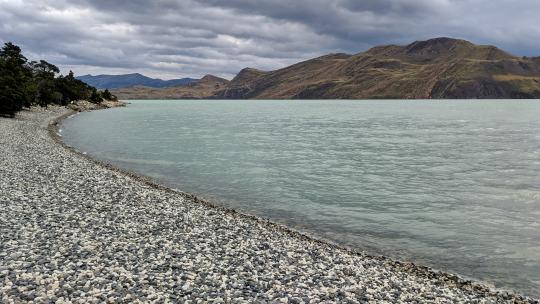
Nice pebbles
youtube
A bit of wind
I have to say a few more words about the water (again). I'm now at a point where I would say that the water here is the best water I ever drank in my entire life. Usually I like to add a little bit of flavour when I drink plain water but here I just couldn't get enough of it. If there is one thing that I will miss most about this place it is the ability to just go to one of these natural taps and drink this wonderful water. My Steripen was only used a couple of times when I knew that there were lots of horses in the area, other than that I never had to treat it at all.
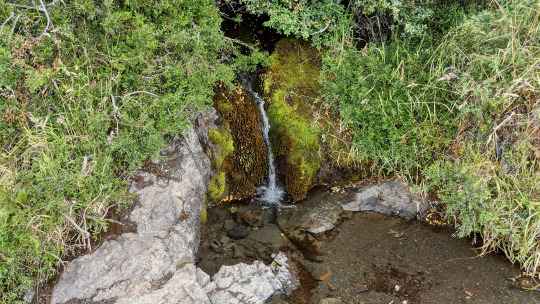
One of the many natural taps
The seventh day was another rest day with only 11 kilometres to walk. Gail and I decided to walk it together and for the majority of the time the trail was just parallel to Lake Nordenskjöld. Towards the end we took a turn at another lake that was named after my second-last car (Inge) before getting back to where it all started about a week ago.
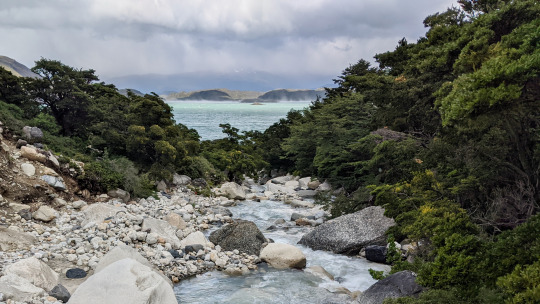
Lake Nordenskjöld
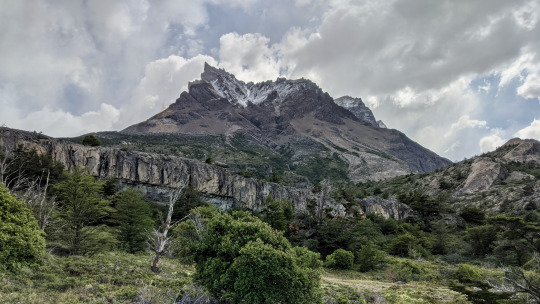
There were a few mountains around

More Lake Nordensköld
The last day was reserved for the hike up to the towers that the park is so famous for. I was hoping that we'd have a clear morning, in which case I would have started in the middle of the night to see the Torres at sunrise - unfortunately the forecast said it would be a cloudy morning, so I rejected that idea. It was supposed to clear up during the day though. A lot of people do this hike as a day hike due to its proximity to the main entrance of the park. I wanted to at least avoid these crowds, so I started two hours before they arrived, hoping for some solitude. It kind of worked. There were already quite a few people on the trail when I made my way up but it was a lot less compared to the masses of people I encountered on my way back. And the forecast was actually true: When I arrived at the base of the towers, it was still a bit cloudy but when I left, I managed to snap a photo of all three towers not being surrounded by clouds. The whole way down it was finally super sunny and I soaked up the much needed sunbeams like a sponge. The towers itself were absolutely breathtaking and I highly enjoyed just sitting there, starring at them for two hours. As you might sense there actually weren't that many jaw-dropping moments during the hike as I originally hoped for, but this was definitely one of them.
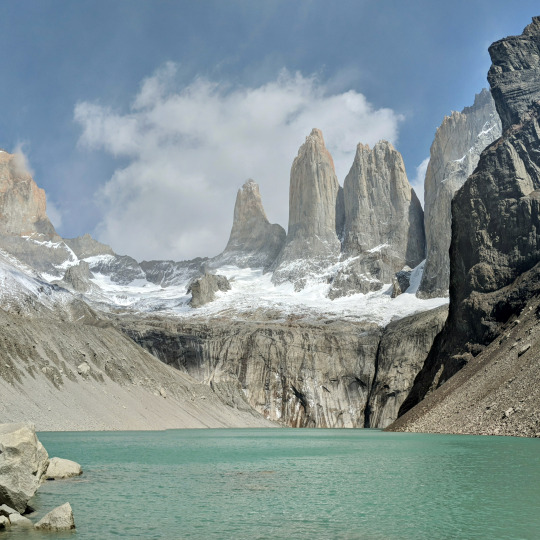
The famous towers
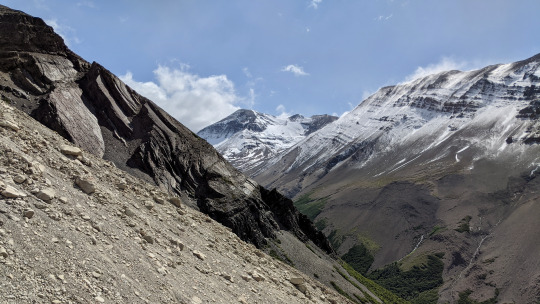
On the way back
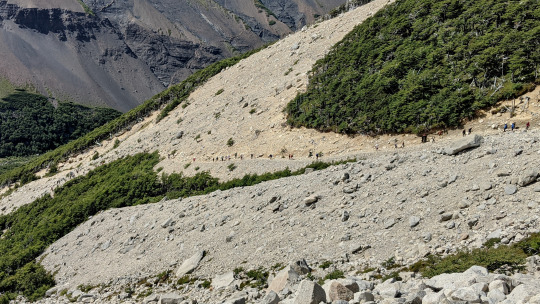
I guess the first bus has arrived
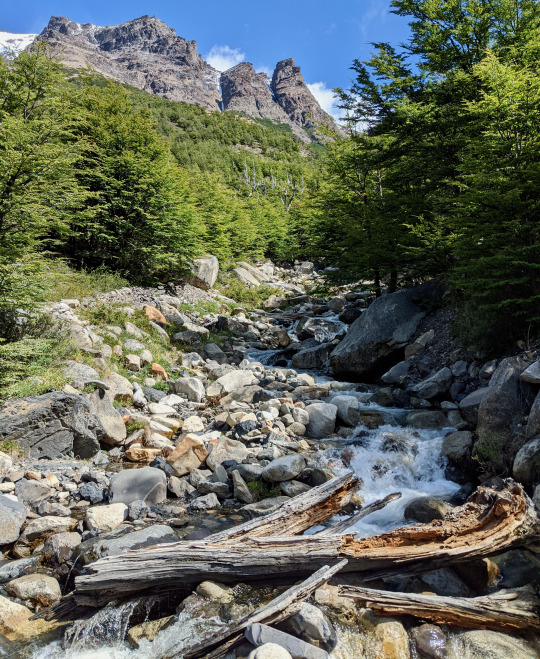
Beautiful water

What a lovely last day it was
All in all I am a little torn about the O. My expectations were definitely a lot higher in terms of everything. I expected it to be a lot more challenging but most days were actually quite cruisy. I also expected it to be a lot more remote - in reality you would never have to wait longer than 5 to 10 minutes until you'd see another human being, even on the back side. Another expectation I had was more wow moments. Don't get me wrong, it is absolutely beautiful and this is complaining on a very high level but I was very rarely blown away by what I saw. Would I do it again? Probably not. Was it still worth it? I think so.
To wrap it up, I quickly wanted to list my top positive surprises and top disappointments.
Top 3 positive surprises:
I fell in love with glaciers
Walking along the beach of Lake Nordenskjöld on the way to Los Cuernos
The hot chocolate at Camp Serón was the bomb
Top 3 disappointments:
Apart from the John Gardner Pass it wasn't very challenging at all (and that part was only challenging due to the weather)
Overall there were too many people
My cash was stolen
Next I will go back to El Calafate in Argentina and hike on the Perito Moreno Glacier on my birthday. After that I will go up North and spend some time in San Carlos de Bariloche which apparently looks like Switzerland and also has amazing chocolate. I will surely put that statement to a test.
1 note
·
View note
Photo

I like glaciers, rainbows, mountains and dead trees
0 notes